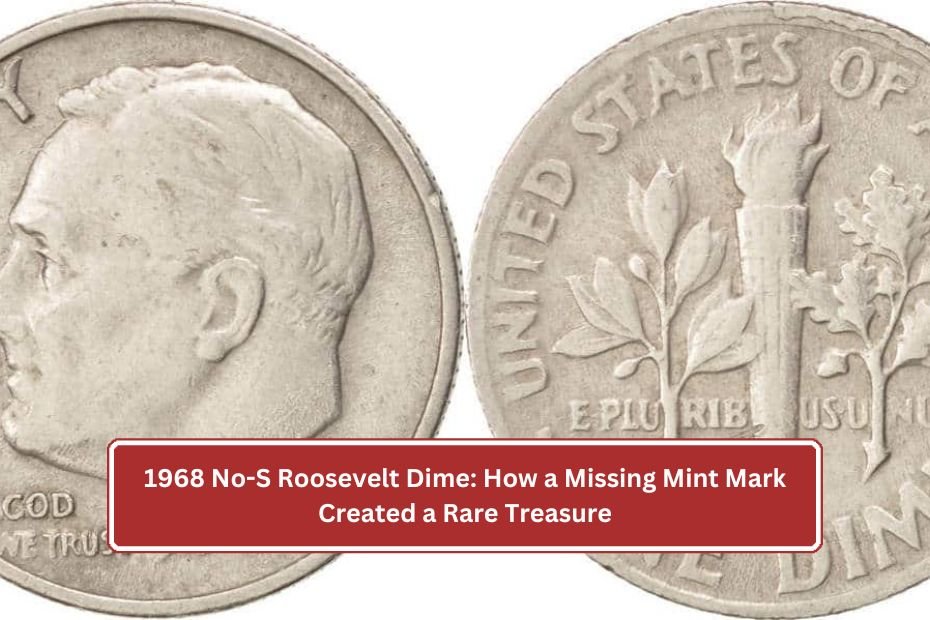Coin collectors and history fans are always excited by unique and valuable coins. Among these, the 1968 No-S Roosevelt Dime is a rare find, missing the “S” mint mark that indicates it was made at the San Francisco Mint. This small minting error has made the 1968 No-S Dime a highly sought-after item, sometimes selling for tens of thousands of dollars. In this article, we’ll look at why this dime is so valuable, explore some of the most valuable $5 coins, and explain what makes these coins collectible.
Overview of the 1968 No-S Roosevelt Dime and Other Million-Dollar $5 Coins
The table below provides a summary of the 1968 No-S Roosevelt Dime and some of the rarest $5 coins ever sold.
| Coin | Year of Mint | Estimated Value | Unique Feature |
|---|---|---|---|
| 1968 No-S Roosevelt Dime | 1968 | $20,000 – $30,000 | Missing “S” mint mark |
| 1822 Capped Head Left Half Eagle | 1822 | $8 million+ | Only three known to exist |
| 1907 Saint-Gaudens Indian Head $5 | 1907 | $1 million+ | Unique design by artist Augustus Saint-Gaudens |
| 1795 Half Eagle | 1795 | $1 million+ | First $5 gold coin produced by the U.S. Mint |
Details of Each Coin
1968 No-S Roosevelt Dime
The 1968 No-S Roosevelt Dime is one of the rarest modern error coins because it lacks the “S” mint mark, a mistake made on only a few proof coins produced at the San Francisco Mint. Proof coins are usually minted with extra care, so errors like this are highly unusual. A 1968 No-S Dime in top condition can be valued at $20,000 to $30,000.
1822 Capped Head Left Half Eagle
The 1822 Capped Head Left Half Eagle is one of the rarest coins in U.S. history. Only three are known to exist, with two held in museum collections. In 2021, one sold at auction for over $8 million, setting a record for U.S. coins. This coin’s value is due to its extreme rarity and historic significance.
1907 Saint-Gaudens Indian Head $5
Designed by renowned sculptor Augustus Saint-Gaudens, the 1907 Indian Head $5 coin is widely regarded as one of the most beautiful U.S. coins ever minted. This unique design and limited mintage make it highly collectible. In high-grade condition, this coin has been known to sell for over $1 million.
1795 Half Eagle
The 1795 Half Eagle holds special significance as one of the first $5 gold coins minted in the United States. Its early date, rarity, and well-preserved specimens make it a prized coin, with values exceeding $1 million in top condition.
Why These Coins Are So Valuable
The value of coins like the 1968 No-S Roosevelt Dime and the high-priced $5 coins comes from their rarity, historical importance, and unique features. Error coins like the No-S Dime are sought after because mistakes are rare, especially in proof coins intended for collectors. Coins like the 1822 Capped Head Left Half Eagle and the 1795 Half Eagle are valuable because they are among the few surviving specimens of early U.S. coinage, with historical appeal to collectors worldwide.
Conclusion
For collectors, the thrill of finding a rare coin like the 1968 No-S Roosevelt Dime or a valuable $5 coin is unmatched. These coins represent more than just their monetary worth; they carry unique stories of minting errors, historic moments, and artistry that make them collectible treasures. Whether it’s a missing mint mark or a beautiful design by a famous artist, each of these coins holds a special place in American coin history. So, keep an eye out—your next collectible treasure might just be hiding in plain sight!
FAQ’s
How rare is the 1968 No-S Roosevelt Dime?
The 1968 No-S Roosevelt Dime is extremely rare, as only a few proof coins were mistakenly minted without the “S” mark. This rarity makes it a highly sought-after collectible.
Why are error coins like the 1968 No-S Dime valuable?
Error coins are rare because mistakes are uncommon in minting, especially in proof coins. These errors make them unique, which drives up demand and value among collectors.
How much is a 1968 No-S Roosevelt Dime worth?
A 1968 No-S Roosevelt Dime in high-grade condition can sell for between $20,000 and $30,000, depending on its preservation and demand.

